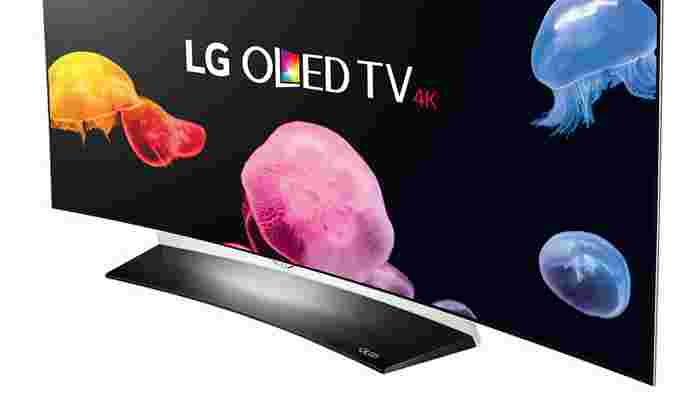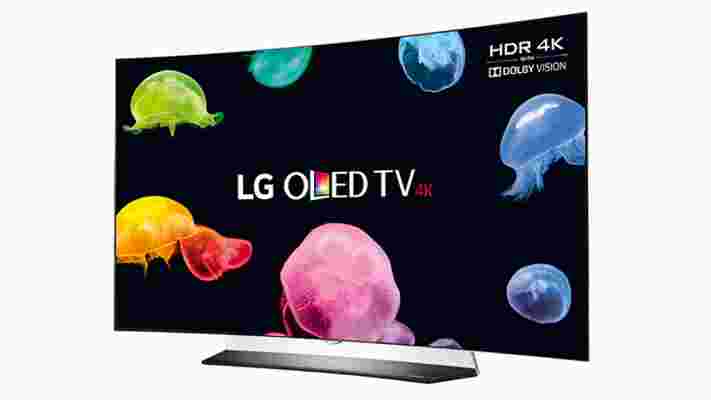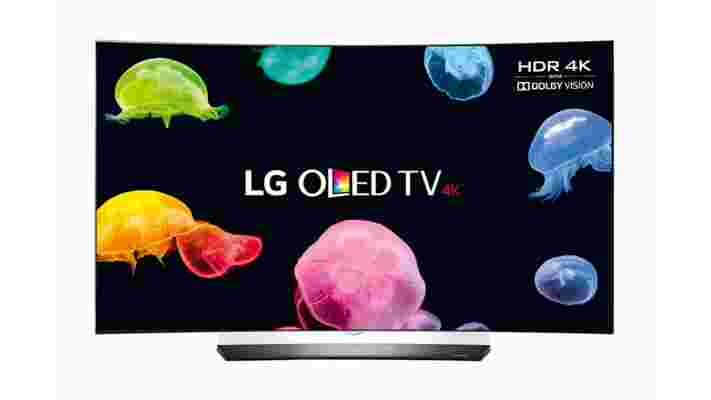LG's OLED TVs have always known how to make an impression. With their ultra-slender bezels, super-slim curved panels and rich, vibrant colour reproduction, even the very best LED TVs looks monstrous when you shuffle them up them side-by-side. The new LG OLED C6V is no exception, and its razor-thin 5mm panel and attractive, see-through stand design make it look as though it's simply floating in mid-air.
It bulks out toward the bottom of the set, where you'll find all its ports and connections, but that doesn't detract from its overall loveliness, making the 55in model on test here look almost every bit as good as you’d want, given its eye-watering £2,299 asking price. I say almost, as its stand is actually quite flimsy, since it’s made from plastic rather than metal. Its brushed, metal-effect finish does go some way to help mask this, but at this price I expect perfection.

Still, once it's installed in your living room, you're probably not going to care too much, especially if you opt to have it wall-mounted. Available in 55in and 65in screen sizes (with the 65C6V costing a whopping £3,799), I would expect image quality to be nigh-on identical across both models.
Picture quality
One of the main attractions of buying an OLED TV over a traditional LED set is its superior image quality. Since every LED pixel produces its own illumination on an OLED TV, it doesn't need any local-area dimming zones or huge edge-mounted backlights to illuminate the panel like traditional LED TVs. Instead, each pixel can simply turn on and off as required, producing pitch-perfect blacks. Indeed, every picture mode I tested hit perfect 0cd/m 2 black across the board, and they all covered 100% of the sRGB colour gamut as well, which isn't surprising given its Ultra HD Premium certification.
The only downside to buying an OLED TV is that they're generally not very bright. On Standard, for instance, I measured a peak brightness of 235cd/m2 with our standard calibration tests, and even the ISF-approved Bright Room mode only hit 215cd/m2. This is almost half as bright as Samsung's KS9000 , and it makes the C6V rather ill-suited to bright, sunlit rooms.
Switch over to HDR content, however, and it's a completely different story. Using a small white test pattern that took up 10% of the screen, my colorimeter measurements shot up to a huge 710cd/m 2 . That fell to around 450cd/m 2 when I used a 25% white pattern, and 250cd/m 2 on a 50% white pattern, but these are still very impressive scores for an OLED set, and come in just under the KS9000's measurements, which topped out at 820cd/m 2 .
As a result, my 4K Blu-rays of The Lego Movie and Batman vs Superman both looked excellent, with light beams, torches and fiery debris practically popping out of the screen. That brightness does come with a bit of caveat, though, as the actual level of detail on show in those bright areas was pretty poor. Indeed, the raging fires in the penultimate fight scene of Batman vs Superman were just one big white mass most of the time, showing very little evidence of the oranges and reds that were visible on the KS9000.
Things improved once I'd dialled down the contrast and tweaked the brightness settings slightly, but the gains were marginal. You're also limited to only three picture modes when viewing 4K HDR content (HDR Bright, HDR Vivid and HDR Standard), which seems quite stingy compared to its regular set of ten.

This is surprising, as OLED TVs should have better contrast than normal LED sets. However, in practice, the C6V struggled to accurately reproduce all the different shades of white and black, whites suffering the most, clipping much earlier than I would like. Turning on dynamic contrast only made this worse. HDR Standard mode produced by far the best results on this front, displaying more individual shades before they petered out altogether, but it's still not as good as I was expecting.
Motion and Colour Management
The C6V's motion handling was also a little hit and miss. While its TruMotion setting managed to make some of our test 4K Blu-rays look slick and smooth, other scenes produced all manner of glitches and artefacts, often wiping out film grain as it tried to keep up. It also tended to lurch from one frame rate to another, speeding up only to slow down a few seconds later. As a result, you'll probably need to dip into its settings menu quite frequently to adapt it as necessary (or just turn it off completely).
At least LG provides a comprehensive colour management system on the C6V, providing plenty of options for fine-tuning your set once you get it home. In addition to two and 20-point white balance options, you also get individual RGBCMY colour options that let you adjust the tint, saturation and overall luminance of the screen. You'll need a colour calibrator to get the most out of these settings, but they're a welcome addition nonetheless.
Buy the LG OLED 55C6V now from Currys

